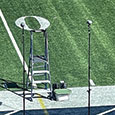Question: How can I improve my articulation?
Answer: Articulation is one of the most crucial aspects in flute playing. There is always something more to learn and to improve. When I ask students if they practice articulation patterns and double tonguing, most say no. Just like flutists work on their fingers, articulation should be part of the warm-up. Remember the tongue is a muscle which requires regular training just like athletes train their muscles. To be honest, it had not occurred to me until I met my teacher Julius Baker, that articulations are something you should work on. I just assumed that good articulation is something that automatically happens as you learn to play better.
In my first lesson with Julius Baker, he had me sightread the second movement of Bach’s C Major Sonata. It was a bit scary to see two pages full of 16th notes, but then he said I could play as slowly as I liked. After listening to my playing, Mr. Baker asked me to bring this again to the next lesson and every lesson from then on. In fact, every lesson began with this for the next four years.
As I look back now, I appreciate how he made me work on double-tonguing without literally saying “You shall practice double-tonguing.” I spent some time every day trying to get better at it, feeling like I was practicing it from my free will instead of someone forcing me to do so. This was his way of tricking me, and I totally fell for it. What a blessing it was to have a teacher like him.
It was a very demanding journey for me in order to play this second movement faster, cleaner, and more precisely than the week before. Of course, the piece in a performance setting is not very fast, however this was a perfect piece for learning double-tonguing. The choice of piece is completely up to you. It does not have to be this particular one. Search for a short piece that has constant tonguing rather than repeating scales with articulations. Always remember to have fun whatever and whenever you play, even in your warm-ups.
When you have selected a piece, start working from a slow tempo. People often ask me how to do the double-tonguing so fast. A rather disappointing (or encouraging) answer for you is that I also started from a slow tempo. Then I built up speed with great patience. Does this sound somewhat familiar? It is just like working on fast passages for your fingers. Don’t despair when you see no progress in a short period of time.
Another concern besides speed is the length of the individual notes. The different lengths of détachés (detached notes) are going to be your artistic vocabulary. The more variation you have, the more you can express.
A very good excerpt to work on for note lengths is the Scherzo from Mendelssohn’s A Midsummer Night’s Dream. You should be prepared to play this at various tempos because every conductor has a different idea about the tempo. When practicing various tempos, also practice various note lengths.
I hear many students playing this scherzo very fast. It is not about speed but how to play with lightness yet controlled pulse, and always with clean attacks even in a slower tempo. When you perform this in a real setting in the orchestra, it is often not as fast as you think. You will be surprised to discover that it is much more difficult to play at a slower tempo and still create the same atmosphere that you get with a faster one.
Another consideration with articulation is cleanness. Have you noticed that as soon as you start a fast-articulated passage the sound is suddenly not focused and becomes airy? In my teenage years this was one of the many mysteries in playing the flute.
When we talk, we use our tongues only to pronounce. Therefore, we don’t give much thought to the tongue. Then, why is there such a big deal about tonguing when we play the flute? One day I noticed that my tongue was very stiff, far more than necessary. So instead of the tongue helping to pronounce a note on the flute, the tongue was actually working counterproductively. When I was younger, I put too much pressure and strength on my tongue. This affected the sound and prevented me from going any faster because the tongue was simply too heavy. The key to clean articulation is to relax.
Knowing that the body parts are all related to one another, flutists have to consciously relax the entire body. Aim to be in the most comfortable and stress-free posture. Check if any of your body parts are tightened, then try to detangle the tension one part at a time.
If you think you are relaxed and ready to go, then find your own golden spot when you double-tongue. You will have to find this using your ears. If you hear an air-leaking noise apart from your nice tone, experiment by changing the angle of the air until the leaking noise reduces. Keep working in this direction and refine your tone.
This noisy or airy sound can also be caused by the placement of your tongue when you articulate. When you talk, your tongue might be in relatively the same place; but in flute playing, you can try some other spots as well. It might give you a better result and also will let your boldest imaginations come to life. Nothing comes easily without any effort, but it can certainly become effortless if you make this practice a habit – and don’t forget to have fun!
* * *
How and What to Practice
When double-tonguing, the K is the weak stroke. First practice without shaping the embouchure, say both T and then K. Both should feel natural for you. Little by little shape your embouchure as if you are playing the flute. Later when you actually play double-tonguing on the flute, pay attention that the K sound matches the T sound.
Send your questions to Ask the Pro at editor@flutetalkmagazine.com






